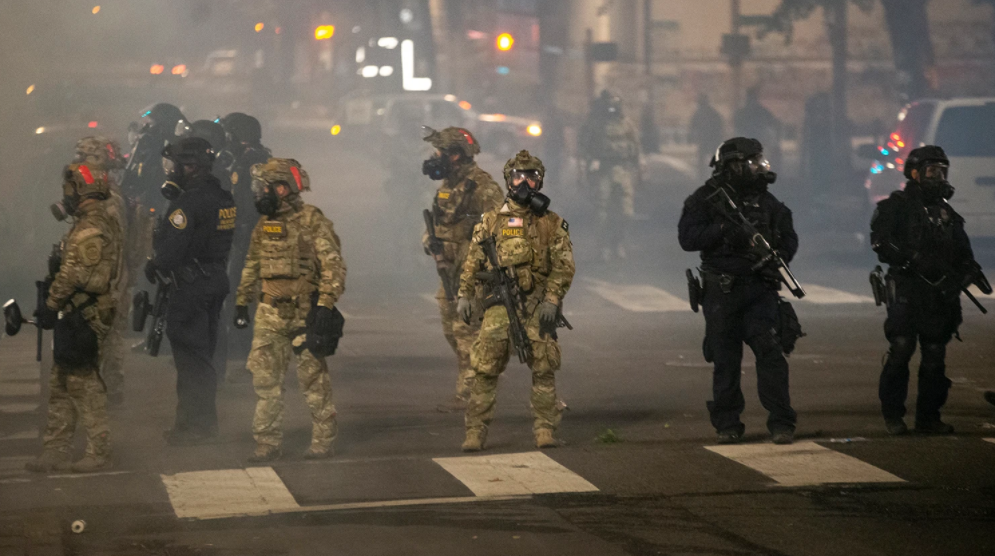The last four years of the Trump administration have sparked renewed interest in right-wing extremism, specifically fascism. As a scholar who focuses on fascism and the extreme right I think this attention is warranted, if a little late. Unfortunately, sudden popular interest in a complex subject doesn’t equate to an adequate understanding of that subject , and oftentimes the media simply compounds the problem. For many readers, and indeed for many popular commentators, breathless questions like “What is fascism?” “Is Donald Trump a Nazi?” or “Who are the real fascists?” tend to generate a lot of heat but little light.
In fact they often help to distract from the day-to-day activity of fascist movements and contribute to their growth. I don’t claim to have definitive answers to these questions, but this article offers a better working understanding of what fascism is, and how to stop it.
Fascism is a modern political ideology and movement of the extreme right-wing. The first stirrings of fascism began in Europe in the late 19th century, but fascism as an organized, political force first appeared in Italy with the rise of Mussolini’s National Fascist Party, with the Nazi Party in Germany following some years later. While these two examples are well-known, they were by no means the only fascist forces in the early and mid-20th century. Almost every European country and dozens of other non-European countries were home to fascist movements and parties, though their ability to exercise power and influence varied.
Some fascists participated in their countries’ governance, as in Spain and Romania. Others were influential but never held power, such as Oswald Mosley’s party in the UK, the British Union of Fascists. Still others were limited to small circles of intellectuals, students, and veterans who hosted reading groups and held rallies. Fascism was, and remains, a ubiquitous political movement that can be found from Chile to Norway, from the US to Brazil, from South Africa to India.
The members of these movements had different goals, tactics and rhetorics, and some of them would have resisted the label “fascist.” But they can be placed in the category of “fascist” based on their fundamental agreement on some very important things.
They were revolutionaries, meaning that they wanted their country’s government to change in radical ways, often railing against mass democracy and advocating dictatorship. They were nationalists, meaning that they thought their country’s majority ethnic, racial, or religious group had a vital role to play in the future of humanity, and casted their opponents as racialized others who were innately diseased, dirty, or dangerous. Often they were critical of capitalism, at least insofar as it threatened the norms and social organization of “traditional” society as they understood it. They were misogynistic, which naturally entailed virulent anti-feminism and opposition to women’s rights, including birth control access and financial and personal independence from men. And fascists all shared, not just a contempt for, but a visceral hatred of the left. From progressives to socialists and communists, fascists considered the left to be their most dangerous enemy, one that needed to be eradicated.
But what united fascists more than anything else was their attitude toward violence. Unlike other members of the right-wing, who might consider violence to be an occasionally necessary evil or justifiable under some circumstance in order to serve a political end, fascists believed that violence was good, full stop. Violence wasn’t just a tool to get what they wanted, it was what they wanted. Fascists believed that violence was good for the society experiencing it, and even better for the man (and it was always a man) committing it. Violence would make both the new world and the new men worthy of inhabiting it.
However, as powerful as they sometimes were, fascists never took power alone. The Italian and German fascist parties were granted power by their King and President, respectively, and governed in cooperation with existing right-wing forces. The Spanish Falange played second fiddle to the military under Francisco Franco. The Romanian fascists tried to take power from their conservative counterparts, but were violently put down.
This lesson — that fascists exercise power in and through coalitions with the rest of the right — comes to us straight from one of the most brilliant political thinkers of the 20th century, Antonio Gramsci. Himself a victim of fascist violence (he died in an Italian fascist prison for the crime of being a communist), Gramsci developed a concept of “hegemony” to explain why some political groups were able to hit far above their weight. Thinking about politics in terms of hegemony helps us understand how relatively small but dedicated groups can capture the national zeitgeist by providing an ideology to move larger, older political groups further to the left or the right.
Unlike an everyday dictatorship, fascism is not immediately imposed from above. It bubbles up from below as an earnest political movement. By infiltrating or cooperating with powerful organizations such as the police, the military, religious communities and factions of the capitalist class, fascists can and have become the violent “enforcers” of a right-wing political coalition. The question then becomes which parts of that right-wing coalition are in a hegemonic position. Which of them calls the shots, provides ideological motivating force, sets expectations and defines common sense? Usually mainstream conservatives are able to maintain their power, but occasionally, as was the case in Nazi Germany, the fascists are able to take control of their coalition. Once in power, fascists have unleashed atrocities and horrors that are unprecedented in human history.
These examples and countless others tell us both of the real dangers of fasicsm, and also help us see how it can be fought in the United States. We are currently witnessing the growth of the largest and most powerful fascist organizations this country has seen since the 1920’s and 30’s. The Proud Boys, Patriot Prayer, the Oath Keepers, and dozens of other smaller organizations openly threaten democracy, plan and carry out violent acts, and cooperate with and pressure Republican politicians to intimidate their opponents. Meanwhile, figures who are sympathetic to fascist positions and tactics have worked their way into the White House and the Republican Party, introducing an opening for unprecedented right-wing extremism within American governance.
If you’ve read this far, you shouldn’t be surprised by any of this. Building tactical coalitions while growing the size and influence of independent fascist groups is precisely how fascists gain power and traction. In the U.S., fascist mobilizing is at a peak and fascists are now capable of significant disruption as the 2020 election approaches. Fascist groups have been planning to disrupt the election for months. Intercepting ballots, harassing progressive and socialist political organizers, and brazenly targeting communities of people of color for voter intimidation are all part of their playbook. Unfortunately, based on my study of the history of fascism and its uptick in the U.S., this violence will not stop with the end of the election cycle. Rather, these groups are likely to accelerate their disruptive activity and strategic violence, no matter who wins the upcoming Presidential election.
In fact, the potential for an increase in fascist mobilizing may become more acute if Trump loses rather than wins. Recall the concept of hegemony: if Trump wins, the Republicans will learn that they can achieve victory by continuing to do what they’re already done, essentially combining their decades-long struggle to disenfranchise voters of color and with their take-over of the Supreme Court to prevent legal and electoral changes that would challenge their ability to maintain control with a minority of voters. Trump’s innovation, adding the extreme right-wing to his electoral coalition, would have proven to be enough.
If Trump loses, some Republicans will decide that the lesson is to walk back the ethno-nationalism that won Trump the White House, essentially trying to return the party to Jeb Bush and Mitt Romney. However, this simply will not work. Those voices have already been tarnished by their cooperation with the Trump administration, however begrudgingly. Moreover, the extreme right-wing, having become a part of the ideological vanguard of the party for the last four years, will not give up its position without a fight. And by fight I do mean fight. As fascists, they will not hesitate to turn to violence to achieve their political goals, not just because violence can help them but because they believe violence to be a good thing for the world. The sections of the Republican coalition that have pragmatically chosen to embrace further right-wing power will find themselves forced into alliance with a growing network of activists and paramilitary organizations who have been planning for political violence for years.
How do we confront and defeat this growing fascist insurgency? First, we must resist the liberal strategy of countering right-wing politics primarily through hand-wringing about the rule of law and invoking abstract norms. Nor will appeals to law enforcement decisively quell fascist activity. As the last few months have demonstrated, much of the law enforcement apparatus in the US, especially local sheriff’s departments, not only support but openly collaborate with fascist elements. Instead, fascists will have to be fought in the same way that they have gained power on the right. Progressives and the left will have to promote a politics that actually seeks to transform the world and correct injustices, one that acknowledges the abject failure of the status quo to meet the needs of all.
A crucial aspect of politics involves forming coalitions and determining who will lead them. For decades the Republicans and Democrats were both led by neoliberals, leaving progressives to decide who is the “least worst” candidate. Now that Trump and his allies in the Republican party have invited in the extreme right-wing, their party’s vanguard is transitioning to a nationalist, racist, and misogynist force driven by these more radical forces. In response the Democrats cannot double down on their neoliberal past. Doing so might result in a temporary victory, but it will lose the war. After all, the preferred platform of the Democrats, that of neoliberal centrism, has played an essential role in staving off the radical change required to halt the rightward march of US politics and has pitted centrists against progressives, leftists and socialists both within and outside of the Party.
The path forward requires putting progressives and the left at the front of the Party, those who proudly defy neoliberal centrism and promote exactly what the Republicans accuse us of: guaranteed free healthcare, free education, food availability, and public housing, open borders, free birth control, a livable environment — all the things that anyone living (or trying to live) in the wealthiest society in history deserves to enjoy.
But this will involve more than simply electing leftist Democrats. It will also requires grassroots organizing and mobilization outside the party to build a new national consensus, change common sense and build material power for genuine democracy.
Pining for the lost consensus of the 1990’s will lead nowhere. We have to intentionally and relentlessly move our coalition to take up stances that challenge right-wing and fascist power, that answer their claims that society is broken and that openly seek to build a fundamentally different and better world. Otherwise, we risk leaving the coming transformation to the fascists and their vision. This is a future we will not survive, and which we will have to fight not just with our ballots but with ideas and organizing.
Craig Johnson is a PhD candidate in Latin American History at UC Berkeley. He studies right-wing politics and conservative Catholic theology in Latin America and Spain. He’s also the host of “Fifteen Minutes of Fascism,” a weekly podcast covering the global rise of the radical right.




